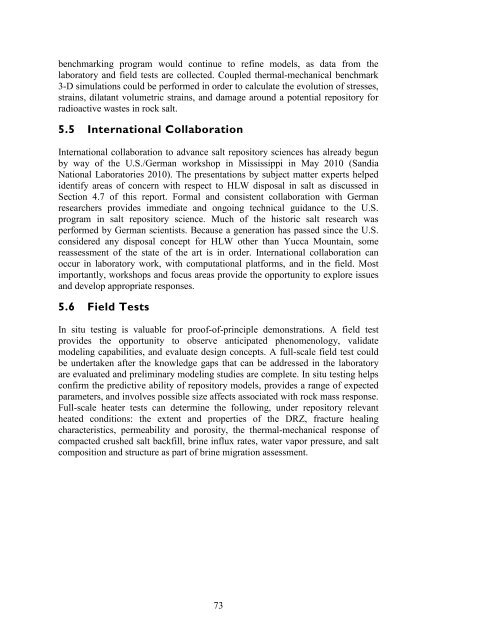Salt Disposal of Heat-Generating Nuclear Waste
Salt Disposal of Heat-Generating Nuclear Waste
Salt Disposal of Heat-Generating Nuclear Waste
Create successful ePaper yourself
Turn your PDF publications into a flip-book with our unique Google optimized e-Paper software.
enchmarking program would continue to refine models, as data from the<br />
laboratory and field tests are collected. Coupled thermal-mechanical benchmark<br />
3-D simulations could be performed in order to calculate the evolution <strong>of</strong> stresses,<br />
strains, dilatant volumetric strains, and damage around a potential repository for<br />
radioactive wastes in rock salt.<br />
5.5 International Collaboration<br />
International collaboration to advance salt repository sciences has already begun<br />
by way <strong>of</strong> the U.S./German workshop in Mississippi in May 2010 (Sandia<br />
National Laboratories 2010). The presentations by subject matter experts helped<br />
identify areas <strong>of</strong> concern with respect to HLW disposal in salt as discussed in<br />
Section 4.7 <strong>of</strong> this report. Formal and consistent collaboration with German<br />
researchers provides immediate and ongoing technical guidance to the U.S.<br />
program in salt repository science. Much <strong>of</strong> the historic salt research was<br />
performed by German scientists. Because a generation has passed since the U.S.<br />
considered any disposal concept for HLW other than Yucca Mountain, some<br />
reassessment <strong>of</strong> the state <strong>of</strong> the art is in order. International collaboration can<br />
occur in laboratory work, with computational platforms, and in the field. Most<br />
importantly, workshops and focus areas provide the opportunity to explore issues<br />
and develop appropriate responses.<br />
5.6 Field Tests<br />
In situ testing is valuable for pro<strong>of</strong>-<strong>of</strong>-principle demonstrations. A field test<br />
provides the opportunity to observe anticipated phenomenology, validate<br />
modeling capabilities, and evaluate design concepts. A full-scale field test could<br />
be undertaken after the knowledge gaps that can be addressed in the laboratory<br />
are evaluated and preliminary modeling studies are complete. In situ testing helps<br />
confirm the predictive ability <strong>of</strong> repository models, provides a range <strong>of</strong> expected<br />
parameters, and involves possible size affects associated with rock mass response.<br />
Full-scale heater tests can determine the following, under repository relevant<br />
heated conditions: the extent and properties <strong>of</strong> the DRZ, fracture healing<br />
characteristics, permeability and porosity, the thermal-mechanical response <strong>of</strong><br />
compacted crushed salt backfill, brine influx rates, water vapor pressure, and salt<br />
composition and structure as part <strong>of</strong> brine migration assessment.<br />
73
















